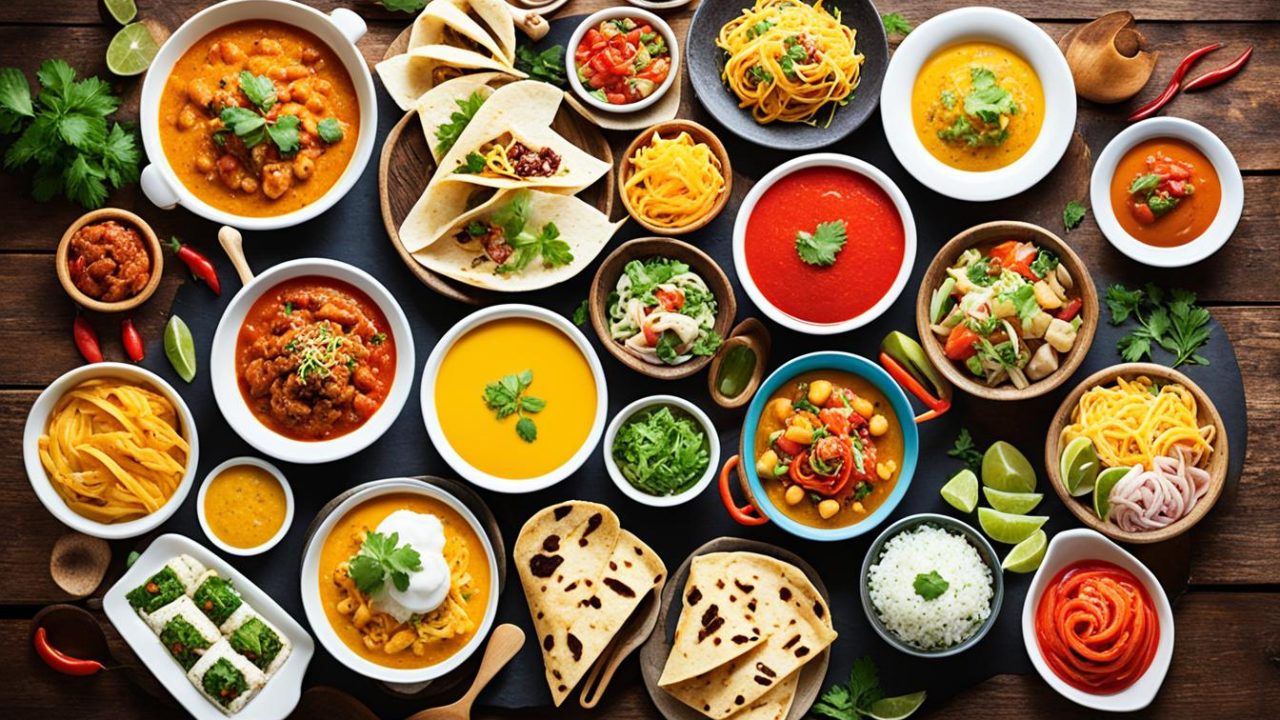Welcome to a gastronomic adventure as we delve into the world of traditional Korean food. In this article, we will take you on a journey to discover the rich flavors and cultural significance of authentic Korean cuisine. From mouthwatering dishes to time-honored recipes, get ready to savor the essence of Korean culinary traditions.
Traditional Korean food is renowned for its unique flavors and meticulous preparation methods. Each dish tells a story, reflecting the country’s rich history and cultural heritage. From kimchi to bulgogi, the diverse range of flavors will tantalize your taste buds and leave you craving for more.
Whether you’re a seasoned food enthusiast or a curious beginner, this article is your gateway to experiencing the best of Korean cuisine. We will provide insights into traditional recipes, explore the vibrant street food scene, and even uncover the health benefits of Korean food.
So, join us on this culinary adventure as we immerse ourselves in the world of traditional Korean food and embrace the authentic delights it has to offer.
Traditional Korean Food: A Culinary Journey
Embark on a culinary journey through traditional Korean food as we uncover the vibrant and diverse flavors that have been passed down through generations. Korean cuisine is known for its rich history and cultural significance, making it an essential part of Korean food culture.
One of the most iconic dishes in Korean cuisine is kimchi – a fermented side dish made from vegetables such as cabbage and radishes. This tangy and spicy dish is not only delicious but also showcases the importance of fermentation in Korean cooking. The unique combination of ingredients and fermentation process result in a distinct flavor that is beloved by locals and foreigners alike.
Another staple dish that exemplifies the essence of Korean food culture is bibimbap. This colorful and nutritious bowl of mixed rice, vegetables, meat, and gochujang (a spicy red pepper paste) is a feast for both the eyes and the taste buds. It represents the harmonious balance of flavors and textures that is characteristic of Korean cuisine.
Throughout our culinary journey, we will explore traditional Korean recipes that have stood the test of time. From hearty stews like kimchi jjigae to savory pancakes like pajeon, each dish tells a story of Korean culinary heritage.

Join us as we delve into the intriguing world of traditional Korean food and discover the secrets behind its unique flavors. From regional specialties to time-honored techniques, this culinary journey will leave you with a deeper appreciation for the rich tapestry of Korean cuisine.
Authentic Korean Food: Unveiling Cultural Heritage
Authentic Korean cuisine not only delights the taste buds but also serves as a window into the rich cultural heritage of the country. Traditional Korean dishes are a reflection of centuries-old customs, rituals, and ingredients that have shaped Korean food culture. Let’s delve into the historical background of Korean cuisine and discover the deep-rooted traditions that make it truly special.
Korean food is deeply intertwined with the country’s cultural heritage, often influenced by its geographical location, climate, and agricultural practices. Historical Korean cuisine draws inspiration from diverse sources, including Confucianism, Buddhism, and royal court traditions. It celebrates the unique flavors of the country’s bountiful land and sea.
At the heart of traditional Korean cuisine are the celebrated ingredients that have been used for generations. From the pungent and versatile fermented cabbage, kimchi, to the nutritious and tender soybean paste, doenjang, these traditional Korean ingredients hold the key to the distinct flavors found in Korean dishes.
The preparation of traditional Korean food involves not just cooking but also encompassing intricate rituals and customs. From the labor-intensive process of making kimchi, which involves salting, fermenting, and pickling, to the ceremonial sharing of food at Korean feasts, these practices deepen the cultural significance of Korean cuisine.
By delving into the historical roots of Korean cuisine, we can gain a deeper appreciation for the flavors and traditions that make it an integral part of Korean cultural heritage. Stay tuned to explore traditional Korean recipes and the modern twists that have evolved over time, as we continue our journey through the diverse and delectable world of Korean food.

Traditional Korean Recipes: From Classics to Modern Twists
Get ready to dive into the world of traditional Korean recipes and embark on a culinary adventure. In this section, we will guide you through a collection of mouthwatering dishes, from cherished classics to modern fusion creations. Whether you’re a seasoned cook or an adventurous beginner, these traditional Korean recipes will allow you to embrace the flavors and techniques that have made Korean cuisine so beloved worldwide.
Let’s start with the iconic dish, bulgogi. This tender and juicy grilled beef marinated in a combination of soy sauce, garlic, and sugar is sure to satisfy your taste buds. Follow our step-by-step instructions to achieve the perfect balance of sweet and savory, allowing the flavors to infuse the meat to perfection. Remember to thinly slice the beef against the grain for maximum tenderness.
For those who prefer a vegetarian option, japchae is a delightful choice. This stir-fried glass noodle dish, combined with an array of vegetables and seasoned with soy sauce and sesame oil, showcases the delicate flavors and textures that Korean cuisine is known for. Add a touch of sesame seeds for a nutty twist and enjoy this healthy and aromatic dish.
But traditional Korean recipes are not limited to the classics. The fusion of traditional and modern culinary techniques has led to an exciting evolution in Korean cuisine. Explore the realm of modern Korean fusion cuisine with dishes like kimchi quesadillas or Korean-inspired tacos. These innovative creations incorporate traditional Korean ingredients into popular Western dishes, resulting in a tantalizing combination of flavors and a fresh take on traditional recipes.
Now, it’s time to put on your apron, gather the ingredients, and explore the world of traditional Korean recipes. From classics like bulgogi and japchae to modern fusion creations, each dish offers a unique glimpse into the rich culinary heritage of Korea. Unleash your creativity in the kitchen and embrace the traditional flavors with a contemporary twist. Let’s get cooking!

Must-Try Korean Street Food: Flavorful Bites on the Go
Experience the bustling street food scene in Korea with this exploration of must-try Korean snacks and street food. From crispy fried chicken to savory pancakes, we will take you on a virtual tour of the vibrant street food markets where these mouthwatering delicacies can be found.
When it comes to Korean street food, the options are endless. One popular Korean snack that you simply cannot miss is the Korean Fried Chicken. Crispy on the outside and juicy on the inside, these delectable chicken bites are often coated in a sweet and spicy sauce, creating the perfect combination of flavors. Whether you prefer it plain or with a fiery kick, Korean Fried Chicken is a must-try street food delicacy.
Another beloved Korean street food snack is the Bindaetteok, a savory pancake made from ground mung beans. Packed with a variety of vegetables and sometimes even seafood, Bindaetteok is a comfort food favorite among locals and tourists alike. Be sure to try it with a side of tangy dipping sauce for an explosion of flavors and textures.
No visit to Korea would be complete without indulging in Tteokbokki, a popular street food dish consisting of chewy rice cakes smothered in a spicy, gochujang-based sauce. This fiery snack is often served with fish cakes and topped with sesame seeds for added flavor. Tteokbokki is the perfect example of Korean street food’s ability to pack a punch in terms of both taste and spice.
For those with a sweet tooth, make sure to sample some Honey Butter Chips. These addictive potato chips are coated with a sweet and savory honey butter seasoning, creating a unique and irresistible flavor combination. It’s no wonder that Honey Butter Chips have become a sensation in Korea, with people lining up to get their hands on a bag.
As you explore the bustling street food markets in Korea, be prepared to encounter a wide range of flavors, textures, and aromas. From traditional favorites to modern innovations, Korean street food offers an exciting culinary adventure that will leave you craving more. So, grab a plate, wander through the vibrant stalls, and indulge in the delicious snacks that make Korean street food a truly unforgettable experience.

Traditional Korean Food and Health Benefits
When it comes to traditional Korean cuisine, the health benefits are as abundant as the flavors. Korean food is known for its emphasis on fresh, nutritious ingredients that contribute to a well-balanced diet. From kimchi to bulgogi, each dish incorporates a variety of wholesome elements that promote overall well-being.
One of the key characteristics of Korean food is its focus on fermented ingredients. Fermentation not only enhances the flavors but also promotes gut health. Kimchi, a staple in Korean cuisine, is a prime example of a fermented food rich in beneficial bacteria that aids digestion and boosts the immune system.
In addition, the Korean diet includes a wide range of nutrient-dense ingredients such as vegetables, lean meats, and seafood. These ingredients provide essential vitamins, minerals, and antioxidants that support various bodily functions and contribute to overall health. The inclusion of various colors and textures in Korean dishes ensures a diverse and well-rounded intake of essential nutrients.
Furthermore, the balanced approach to eating in Korean cuisine is another factor that contributes to its health benefits. The traditional Korean diet consists of a combination of grains, proteins, vegetables, and fermented foods, offering a well-rounded and nutritious meal. This balance not only aids in weight management but also provides sustained energy throughout the day.
In conclusion, traditional Korean food not only satisfies the taste buds but also offers numerous health benefits. By incorporating fresh, nutritious ingredients and following a balanced approach to eating, Korean cuisine provides a wholesome and flavorful choice for those looking to support their overall well-being through their diet.






